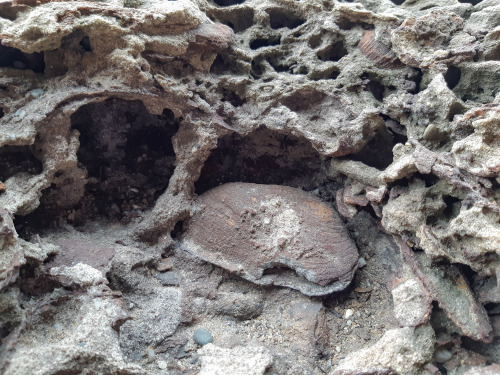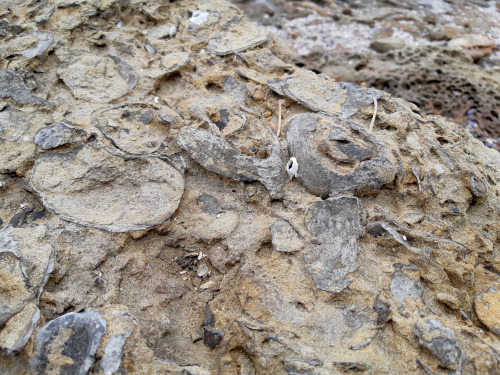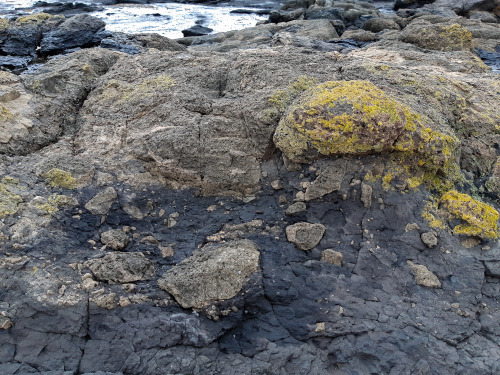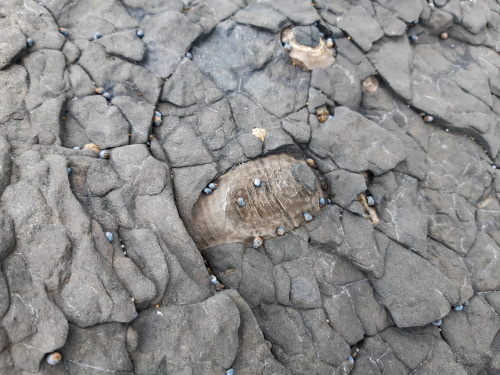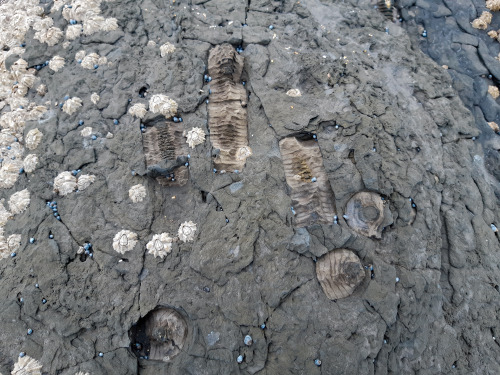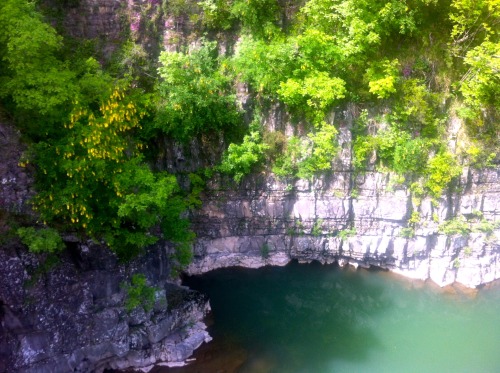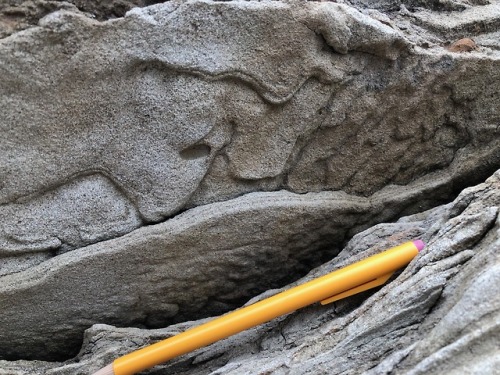#sedimentary

Greywacke with a pretty impressive quartz vein in Arrowtown, NZ
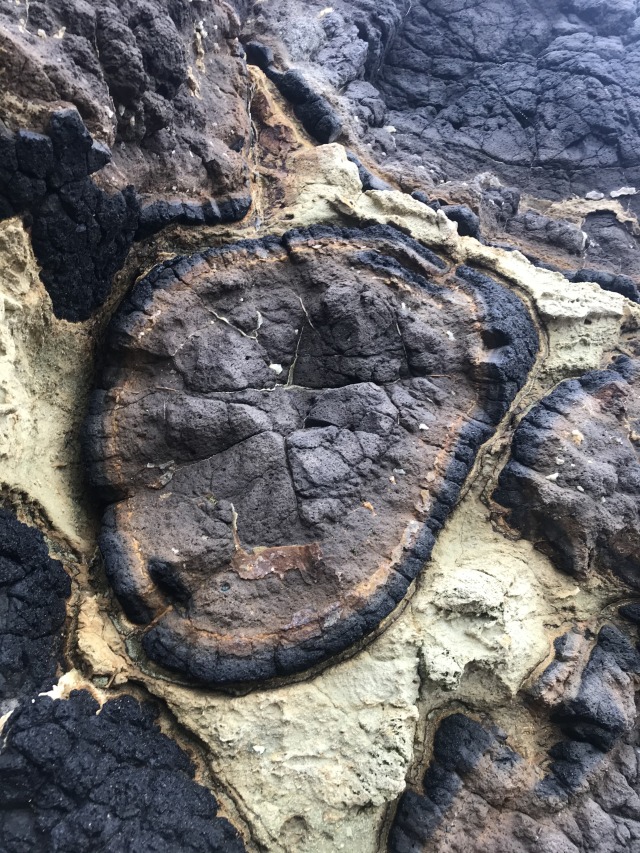

basalt pillow lavas in oamaru, New Zealand
Do not be fooled by this incredibly well preserved shell, it is not a recent shell, but a 250 million year old fossil.
Many different mollusc fossils are very well preserved at this outcrop which consists of layer upon layer of sediment which slowly accumulated on the sea floor during Permian times. Organisms such as this one, would have thrived here, feeding on the organic matter settling down to the bottom of the sea.
Southcoast NSW, Australia
Post link
Ancient sea bottom exposed along a modern seaside rocky platform. This immense amount of fossilized shells is preserved in ~250 million year old sea sediments which would have been a feeding grounds for all these bivalves.
South coast, NSW, Australia.
Post link
Every rock that crops out of the ground is a record of the past, and so, in one way or the other it tells something about the environment in which it was formed. For example, the dark grey rock with fine and smooth texture you can see on the photo, looks that way because it formed on deep water sea bottom, where waves did not disturb the sediment that make up this rock, nor coarser sandy material was brought into it. This was a clam environment which allowed the sea-bottom animals to feed on the organic matter within the sediment (hence the dark colour) and is the reason why there are so many fossils in it, which I showed in the ‘underwater lilies’ post.
So, it is all good, and all makes sense!
But, then there are those large pieces of light grey rock (not shown, but some bigger than sedan car) with rough texture and little holes. Like you can see, its pieces are larger than anything else in a vicinity and are scattered all throughout the dark grey rock. This light grey rock does not belong to the sedimentary environment it is in, it got to where it is by other means than the sediment that surrounds it. And so, the plot thickens…
South coast NSW, Australia
Post link
Fossilized bivalve shells buried in an ancient sea sediments are receiving daylight for the first time in ~250 million years. These sediments are rich in iron minerals, which has replaced the carbonate shell material and preserved the original texture of the shell. Thank you iron oxides for preserving the growth layering of this shell for us to admire.
Beach-side outcrop in southeastern Australia.
Post link
Underwater Lilies
These barrel-shaped pieces are fragmented crinoid stems. This type of crinoid was a underwater lily-like creature which fed on the organic matter suspended in the water. Unfortunately, only stems were preserved at this outcrop, other elements were not found.
South Coast, NSW, Australia.
Post link
Working in the field is a wonderful experience. On the central Oregon Coast, the vast sequence of sedimentary rocks provides a wonderful training ground for geologists. Present on this one outcrop on the beach in North Cove at Cape Arago are many of the common sedimentary structures. Pictured top to bottom are: flame structures, flute casts, and convolute bedding.
Flame structures are a form of soft sediment deformation, which is disturbance in the nice flat beds of sandstone due to the compaction from the weight of overlying material. These sandstones were deposited in a shallow marine area, just offshore of the ancient Oregon coast, and contained a lot of water as a result. The weight of sand and mud deposited in the future caused these old sands to release their water, disturbing the neat layers and laminations of this rock. In the case of flame structures, small points of sediment are forced into overlying beds. These can indicate the ancient flow direction of whatever water deposited the sediment, which is useful for reconstructing the geologic history of a site.
Flute casts are not musical, and are related to the way streams move sediment. Shallow water moves sediment in interesting ways, but if you ever look into a shallow stream on a beach, you’ll see scooped-out holes in the bed of the stream. These result from scour and other sediment movement behaviors causing pits. Later sand was deposited on top of these flutes, filling them up and solidifying, preserving a cast of the ancient stream bed.
Convolute bedding is another form of sediment deformation. These are a type of fluid escape structure, which form in a similar way to flame structures. When water is forced out of the rock be overlying material, the water moves sand grains and sediment around, causing the beds to realign in these odd shapes.
All of these sediment structures go toward reconstructing the history of this part of Oregon, and the scenery that surrounds them adds to the mystique of the tales the rocks have to tell.
Post link
What do you call lazy sandstone?
Sedentary rock.
STROMIEC
Stromiec is a peak in the Kaczawskie Mountains. It is built of Upper Cretaceous marls, limestones and sandstones, which make at its summit a 200 m long rock wall with a few caves inside. These sediments are part of the geological unit known as the Wleń Graben. The mountain is covered with spruce and beech forests. Stromiec is visible from a distance thanks to the characteristic cone-like silhouette, and it’s easy to mistake it for Ostrzyca Proboszczowicka although Stromiec unlike the former it is not an extinct volcano.







A geological introduction to the rocks of New York’s Hudson River Valley.

The simplest kind of fault
When rocks tear and break they can do so in a variety of ways, depending on whether they are being pulled apart (aka extension to geologists), pushed together (compression) or slid alongside each other (strike slip, like the San Andreas) by the tectonic forces affecting the area. This example is a normal fault from Iran, produced by pull apart forces, at least on a local level. The layers pick out very well the block of rock that has dropped between two others, and the two fault lines bordering it. The tectonics in Iran are complex, the main forces are compressive as Arabia separates from Africa and is in a slow motion collision that is closing the Persian Gulf. As the rock is pushed out of the way and uplifted to form mountains such as the Zagros range some regions are twisting and buckling in a rotatory motion, leading to local extensive forces and normal faulting.
Loz
Image credit:
https://twitter.com/HaakonFossen

